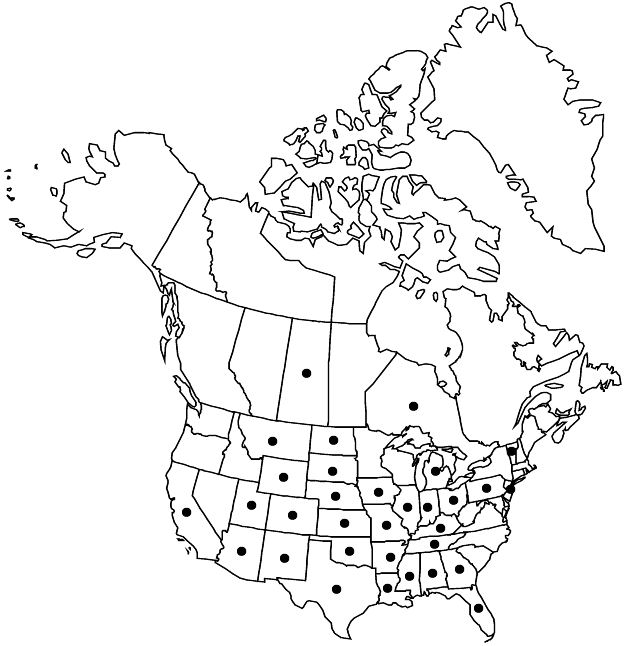Euphorbia serpens
Nov. Gen. Sp. 2(fol.): 41; 2(qto.): 52. 1817.
Herbs, annual, with slender taproot. Stems prostrate, frequently mat-forming and rooting at nodes, 15–50 cm, glabrous. Leaves opposite; stipules connate into conspicuous, deltate scale, white to pink, membranaceous, 0.5–1 (–1.2) mm, glabrous; petiole less than 1 mm, glabrous; blade ovate, oblong or orbiculate, 2–7 (–9) × 2–6 mm, base asymmetric, rounded to subcordate, margins entire, apex rounded, surfaces without red blotch, glabrous; usually only midvein conspicuous. Cyathia solitary at distal nodes; peduncle 0.5–1 (–2.5) mm. Involucre campanulate to turbinate, 0.3–0.7 (–1) × 0.4–0.6 mm, glabrous; glands 4, yellow, oblong, 0.1 × 0.2 mm; appendages white to pinkish, equal, forming narrow rim at edge of gland, 0.1–0.2 × 0.2–0.3 mm, distal margin entire or crenulate. Staminate flowers 5–10. Pistillate flowers: ovary glabrous; styles 0.2 mm, 2-fid 1/2 to nearly entire length. Capsules broadly ovoid, oblate, or subglobose, 1.3–1.4 × 1.3–1.7 mm, glabrous; columella (0.9–) 1–1.2 mm. Seeds white to gray or light pink, ovoid, bluntly 3–4-angled in cross-section, 0.7–1.1 × 0.4–0.7 mm, smooth.
Phenology: Flowering and fruiting year-round (in warmer areas) or summer (in temperate regions).
Habitat: Mostly sandy or well-drained soils, desert scrub, coastal scrub, chaparral, oak and juniper woodlands, sand dunes, riparian forests, mesquite grasslands, prairies, coniferous and deciduous hardwood forests, disturbed areas.
Elevation: 0–2000 m.
Distribution

Ont., Sask., Ala., Ariz., Ark., Calif., Colo., Fla., Ga., Ill., Ind., Iowa, Kans., Ky., La., Mich., Miss., Mo., Mont., Nebr., N.J., N.Mex., N.Dak., Ohio, Okla., Pa., S.Dak., Tenn., Tex., Utah, Vt., Wyo., Mexico, West Indies, Bermuda, Central America, South America, in Europe, Asia, Africa, Australia
Discussion
Euphorbia serpens is one of the most widespread species of the genus in the New World. While it may be indigenous to a portion of the flora area, probably in the warmer, southern part of its range, it is weedy and has likely been introduced in many parts of the flora area, such as Canada and the eastern United States. It is also widely distributed in the Old World, where it is certainly introduced. The strictly prostrate habit with stems rooting at the nodes is characteristic. Euphorbia serpens is often confused with E. albomarginata, a species distributed in the southwestern United States; in addition to the features mentioned in the key, an easy and reliable way to distinguish between them is by the size of the involucral gland appendages: those of E. albomarginata are conspicuous to the naked eye, whereas those of E. serpens are inconspicuous.
Selected References
None.
Lower Taxa
"connate" is not a number. "distinct" is not a number."/2" is not declared as a valid unit of measurement for this property.